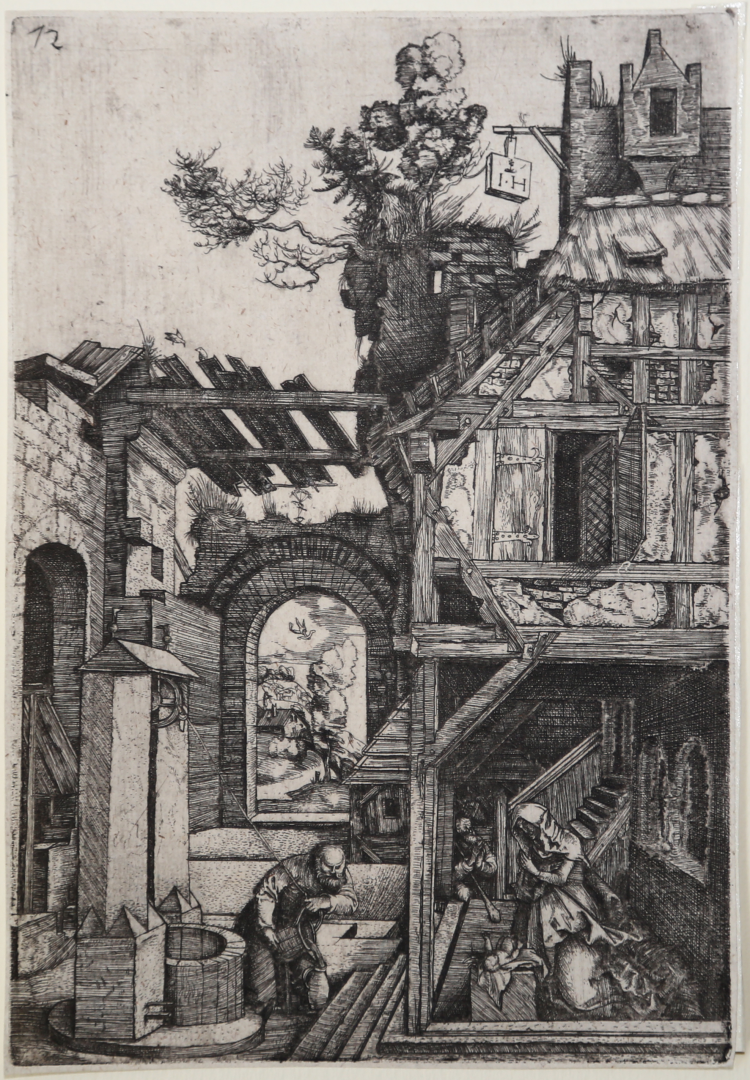




| Reference: | S6786 |
| Author | Hieronimus HOPFER |
| Year: | 1550 ca. |
| Measures: | 158 x 223 mm |



| Reference: | S6786 |
| Author | Hieronimus HOPFER |
| Year: | 1550 ca. |
| Measures: | 158 x 223 mm |
The Nativity; reverse copy after Dürer's engraving (Meder 2) Mary and the Christ Child in the dilapidated half-timber building on r, Joseph at the well in the courtyard on left.
Etching on iron, Signed on a tablet, upper right: 'I.H'.
Example in the second state of three with the number 12 added at upper left.
Magnificent proof, with good contrast and sharp details, on laid paper, no watermark, trimmed at the platemark or with very narrow margins, in very good conditions.
This print derives from Durer's engraving bearing the same name, of which this work is a mirror-image.
Ex collection J. H. von HEFNER ALTENECK (1811-1903).
|
Bartsch VIII.506.1; Hollstein 1, II/III.
|
Hieronimus HOPFER (Augsburg 1500 circa - Norimberga 1563)
|
The Hopfers were a German family of engravers. In 1497 Daniel Hopfer married Justina Grimm, sister of the publisher and humanist Sigismund Grimm. From the marriage were born sons Hieronymus and Lambert, who followed their father's profession and worked with him. Daniel made more than 130 prints of various subjects for the market of the time, Hieronymus 77 and Lambert 34. They placed their initials within the design in almost all of their prints (D.H., I.H., L.H.), adding a small emblem, such as the pine cone in the Augsburg city coat of arms, or a hop flower, in reference to the family name. Hieronymus Hopfer (Augsburg, c. 1500 - Nuremberg, 1563) was born around 1500. Only few biographical data are known: in 1529 the Augsburg City Council allowed him to go to Nuremberg for a year while, in 1531, Hopfer completely renounced his traditional civil rights and after 1550 he died in Nuremberg. Most of the known works are copies based on woodcuts and engravings by German (Dürer, Cranach) and Italian (Barberi, Campagnola, Mantegna) artists, as well as engravings based on medals and reliefs. Unlike Dürer and the other Nuremberg masters of engraving, Hieronimus Hopfer used to make his works in etching and on iron plate rather than copperplate, a technique in which he was a specialist.
|
|
Bartsch VIII.506.1; Hollstein 1, II/III.
|
Hieronimus HOPFER (Augsburg 1500 circa - Norimberga 1563)
|
The Hopfers were a German family of engravers. In 1497 Daniel Hopfer married Justina Grimm, sister of the publisher and humanist Sigismund Grimm. From the marriage were born sons Hieronymus and Lambert, who followed their father's profession and worked with him. Daniel made more than 130 prints of various subjects for the market of the time, Hieronymus 77 and Lambert 34. They placed their initials within the design in almost all of their prints (D.H., I.H., L.H.), adding a small emblem, such as the pine cone in the Augsburg city coat of arms, or a hop flower, in reference to the family name. Hieronymus Hopfer (Augsburg, c. 1500 - Nuremberg, 1563) was born around 1500. Only few biographical data are known: in 1529 the Augsburg City Council allowed him to go to Nuremberg for a year while, in 1531, Hopfer completely renounced his traditional civil rights and after 1550 he died in Nuremberg. Most of the known works are copies based on woodcuts and engravings by German (Dürer, Cranach) and Italian (Barberi, Campagnola, Mantegna) artists, as well as engravings based on medals and reliefs. Unlike Dürer and the other Nuremberg masters of engraving, Hieronimus Hopfer used to make his works in etching and on iron plate rather than copperplate, a technique in which he was a specialist.
|